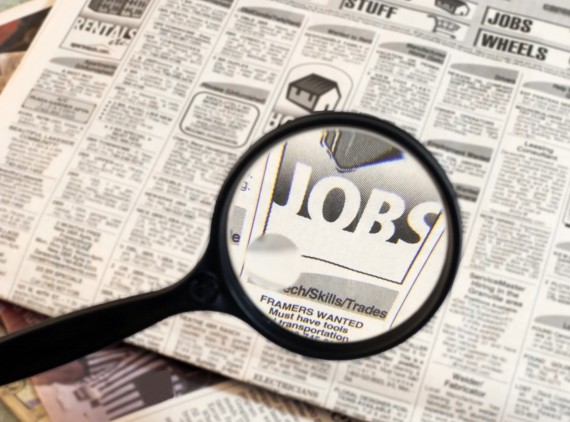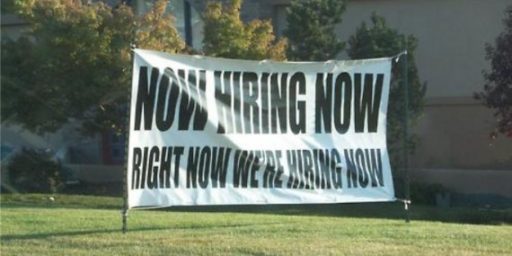April Jobs Report Bounces Back From March Doldrums
The Jobs Report for April showed much-improved numbers from the disappointment in March.
After a disappointing March, the U.S. jobs market bounced back in April to deliver numbers more consistent with what we’d been seeing at the end of 2016 and the start of the new year:
Total nonfarm payroll employment increased by 211,000 in April, and the unemployment rate was little changed at 4.4 percent, the U.S. Bureau of Labor Statistics reported today. Job gains occurred in leisure and hospitality, health care and social assistance, financial activities, and mining.
Both the unemployment rate, at 4.4 percent, and the number of unemployed persons, at 7.1 million, changed little in April. Over the year, the unemployment rate has declined by 0.6 percentage point, and the number of unemployed has fallen by 854,000. (See table A-1.)
Among the major worker groups, the unemployment rate for adult men declined to 4.0 percent in April. The jobless rates for adult women (4.1 percent), teenagers (14.7 percent), Whites (3.8 percent), Blacks (7.9 percent), Asians (3.2 percent), and Hispanics (5.2 percent) showed little change. (See tables A-1, A-2, and A-3.)
The number of long-term unemployed (those jobless for 27 weeks or more) was essentially unchanged at 1.6 million in April and accounted for 22.6 percent of the unemployed. Over the year, the number of long-term unemployed was down by 433,000. (See table A-12.)
The labor force participation rate, at 62.9 percent, changed little in April and has shown little movement over the past year. The employment-population ratio, at 60.2 percent, was also little changed over the month but was up by 0.5 percentage point since December. (See table A-1.)
(…)
Total nonfarm payroll employment increased by 211,000 in April. Employment rose in leisure and hospitality, health care and social assistance, financial activities, and mining. (See table B-1.)
In April, leisure and hospitality added 55,000 jobs. Employment in food services and drinking places continued to trend up over the month (+26,000) and has increased by 260,000 over the year.
Employment in health care and social assistance increased by 37,000 in April. Health care employment continued to trend up over the month (+20,000). This is in line with the industry’s average monthly job growth during the first quarter of this year but below the average gain of 32,000 per month in 2016. Social assistance added 17,000 jobs in April, with all of the gain in individual and family services.
In April, financial activities added 19,000 jobs, with insurance carriers and related activities accounting for most of the gain (+14,000). Over the year, financial activities has added 173,000 jobs.
Employment in mining rose by 9,000 in April, with most of the increase in support activities for mining (+7,000). Since a recent low in October 2016, mining has added 44,000 jobs, with three-fourths of the gain in support activities for mining.
Employment in professional and business services continued to trend up in April (+39,000). The industry has added 612,000 jobs over the past 12 months.
Employment in other major industries, including construction, manufacturing, wholesale trade, retail trade, transportation and warehousing, information, and government, showed little change over the month.
Additionally, the Bureau of Labor Statistics reported that the net jobs number for February was revised upward from +219,000 to +232,000 and that March’s numbers for March were revised downward from the previously reported +98,000 to an even more disappointing + 79,000, making total revisions for the two months a net -6,000 for those two months. This puts average reported jobs gains for the past three months at +174,000. For 2017 as a whole, the total reported jobs gains now stand at +738,000 and average job gains for the year to date at +184,500 per month. This is somewhat better than where the averages stood last month, but still below the average pace we saw for 2016 as a whole, although that may be due largely to the low numbers in March which now appear as though they may have been something of a fluke.
Looking behind the immediate numbers, the picture is rather mixed. On the good side, the topline unemployment number dropped from 4.5% to 4.4% and the broader U-6 measure of unemployment fell from 8.7% to 8.6%, hitting another pre-recession low At the same time, as noted above, the labor-force participation rate and total population of employed persons were both largely unchanged, suggesting that the tightening in the jobs market that has been talked about in recent months . Additionally, the average number of hours worked in a week rose slightly for the broader economy while average hourly earnings increased by 7 cents. Over the past year, average hourly earnings have increased by 65 cents, representing a 2.5% increase in hourly earnings.
One area of concern in these numbers remains the fact that labor force participation remains at near-historic lows notwithstanding an improved economy. Many analysts have suggested that this is due largely to the retirement of the Baby Boomers, but the numbers also suggest that there remains some segment of the population out there who are who so discouraged about finding a job that they’ve basically given up. Economist Steve Ratner, who worked in the Obama Administration on the bailout of the auto industry, also seems concerned, and posts this chart showing that the United States is near the bottom when it comes to labor force participation among advanced countries:
Despite strong jobs growth, LF Participation flat at 62.9%. In particular, decline of prime age men in LF is v concerning. via @jasonfurman pic.twitter.com/CvzNKrvqfD
— Steven Rattner (@SteveRattner) May 5, 2017
Even as we reach historically low numbers in the topline U-3 unemployment rate, the fact that longer term unemployment still remains high, and that there are so many people who are essentially sitting out of the jobs market completely remains a cause for concern.
Finally, this month’s reassuringly stronger jobs report comes at the same time other economic statistics have been, at best, mixed in signaling what direction the economy is likely to take going forward. It also comes just days after the Federal Reserve Board decided not to raise interest rates On the one hand, soft data such as consumer confidence suggests that the economy is poised to strengthen significantly and that what we saw in March was something of an anomaly. On the other hand, there’s the hard data such as March’s weak jobs number and the fact that the first estimate of Gross Domestic Product showed that the economy barely grew during the first three months of the year as well as data from the retail sector showing that the weakness there, which is part of a longer-term trend that has been impacting ‘bricks and mortar’ stores for awhile now, will continue into the foreseeable future. Given the importance of the retail sector in particular to the economy as a whole, that could mean problems ahead for the employment in particular.





Donald Trump: “As you know, our administration inherited many problems across government and across the economy. To be honest, I inherited a mess. It’s a mess.”
I agree with Trump. These numbers are rigged!
winning, part 10……
notice the lack of comments in here vs. during the obama reign?
@bill:
I’ve noticed the lack of pro-Trump commenting going on here, that’s for sure.
Hopefully Trump will be able to continue the good economic policies and results that were a hallmark of the Obama Administration.
One problem I see are the closures of retail stores. Almost weekly another major store goes out or cuts locations. And you hear rumors about this or that store going out.
Look at Sears: some time ago Sears was on top. Now look at it. An American institution. Somehow it seems like maybe the government should have done something here. I don’t know. If Sears goes, anything is at risk.